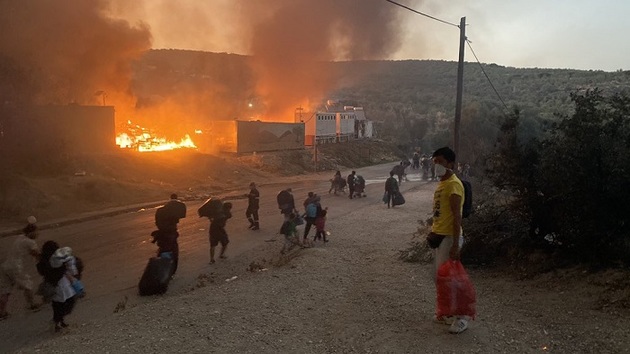The fire that devastated the Moria refugee and migrant camp generated lots of crocodile tears in the EU, yet the grave problem of 13,000 people crowded into a facility created for 3,000 to 4,500 still remains — just as it has for over four years now, Greek Reporter writes in the article Europe’s Hypocrisy Over the Migrant Crisis in Greece. So the reception and identification camp on Lesvos became a kind of a jail — with an unlimited capacity.
It is hypocritical on the part of the Greek government to search for the perpetrators because no one in the camp was happy to be there. Not the families from Syria. And definitely not the individual young men from Afghanistan, Pakistan, Bangladesh, North and sub-Saharan Africa. So seeking out the guilty ones who set the fires is not at all significant. The living conditions in the Moria camp were inhuman. Perhaps this was part of the plan to deter more migrants arriving from Turkey. It seems that no efforts were made to limit the number of humans piled up inside Moria. So it was just a matter of time before the lid blew up.
Let’s not forget that the Moria camp was built in 2013 as an identification center of the Greek police for people wishing to seek asylum. It was supposed to be a temporary accommodation until all the asylum requests and relevant procedures were completed. Yet that changed drastically in 2015 when the influx reached gargantuan proportions reminiscent of the refugee flows of World War II.
At the time, migrants and refugees were free to move to the European country of their choice. But all that changed within a year, when in 2016 Europe shut its borders to asylum seekers, as each European country received dozens or even hundreds of thousands of them.
With the closure of the so-called “Balkan corridor,” gradually all the European borders closed, leading to a significant number of refugees and asylum seekers being trapped on Greek territory.
That was when the agreement between the EU and Turkey came into being, with its core being the attempt to stop the flow of refugees into Europe. The stated goal was for Turkey to prevent the departure of refugees from the Turkish coast, and for Europe to return them to Turkey if they managed to reach the Greek islands.
The key to this agreement was for asylum seekers to remain on the Greek islands. To be precise, the provisions of the agreement were that they would remain on the islands and would not move to the Greek mainland.
That is, the EU agreement with Turkey was that asylum seekers would remain trapped in Greece — and more specifically would remain trapped in the Greek islands — until they returned to Turkey. At the same time, Europe was indirectly sending the message that it was not at all a given that one would obtain asylum after landing in Greece with the intention of moving further into the continent. Additionally, the poor living conditions in camps like the one in Moria were meant to discourage asylum-seekers.
The EU poured money into places like Moria, but not to improve the living conditions. The purpose was — and is — to give the Greek government money to sustain them and keep migrants and refugees there for an indefinite time.
At the moment, the questions that need to be answered directly are whether Europe is willing to take in more migrants and refugees, if the nations of the EU are willing to aid Greece in stopping the limitless migrant flow arriving from Turkey. The EU’s kind wishes of sympathy and solidarity will not suffice any longer.






